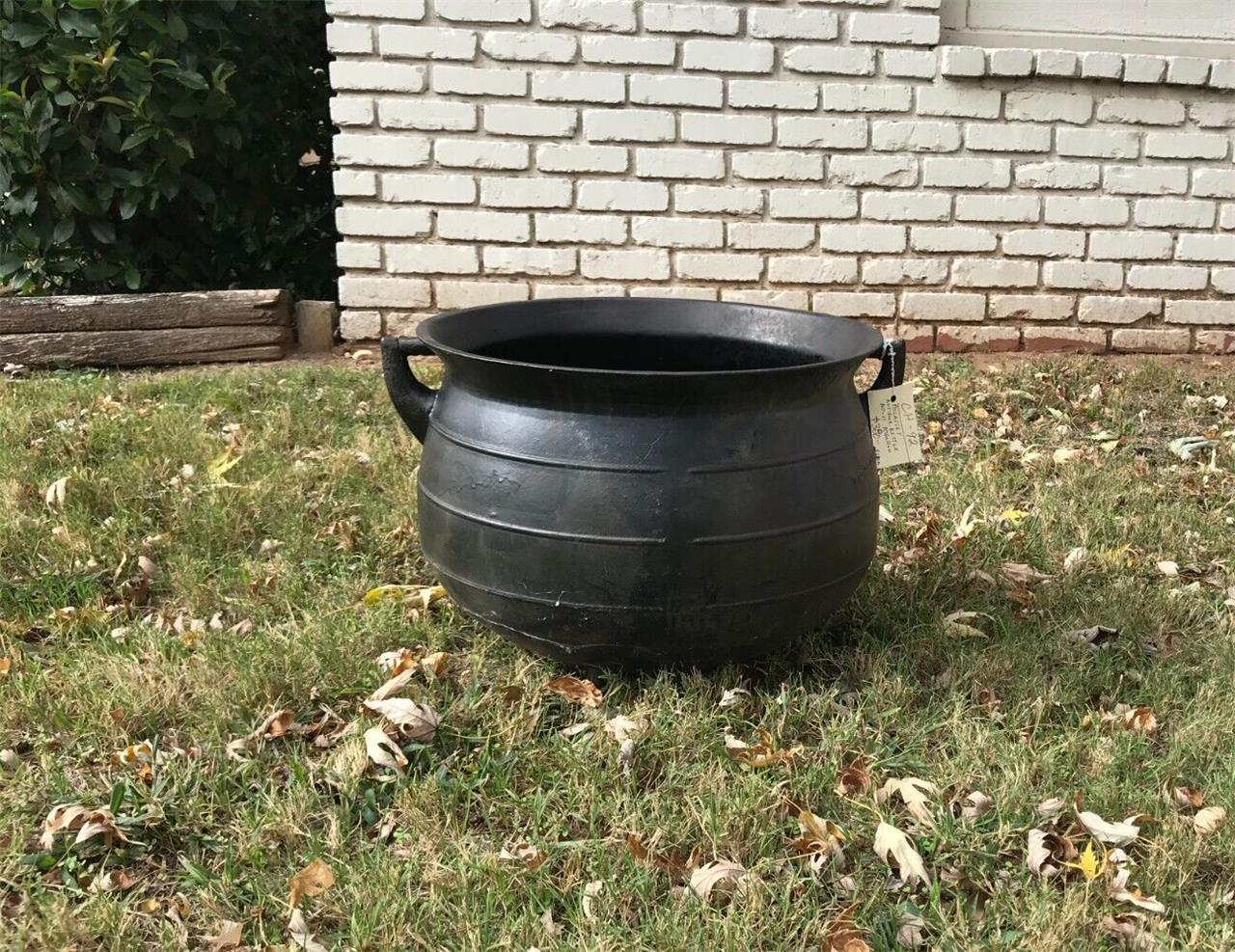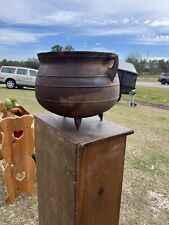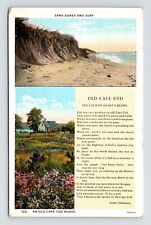When you click on links to various merchants on this site and make a purchase, this can result in this site earning a commission. Affiliate programs and affiliations include, but are not limited to, the eBay Partner Network.
OLD POCASSET CAST IRON CAULDRON KETTLE METAL POT 10G #11 FALL RIVER COWBOY COOK OLD POCASSET CAST IRON CAULDRON KETTLE METAL POT 10G #11 FALL RIVER COWBOY COOK Description
GREETINGS, FEEL FREE
TO
\"SHOP NAKED.\"©
We deal in items we believe others will enjoy and want to purchase.
We are not experts.
We welcome any comments, questions, or concerns.
WE ARE TARGETING A GLOBAL MARKET PLACE.
Thanks in advance for your patronage.
Please Be sure to add WDG to your favorites list!
NOW FOR YOUR VIEWING PLEASURE…
SUPERB CAST IRON KETTLE
MANUFACTURED BY POCASSET MANUFACTURING
OF RIVER FALLS MASSACHUSETTS
c. 1880 - 1890
SUSPECT RETAILER WAS WEED & CORNWELL
THE CAULDRON HAS A CHATOYANCE / PATINA
IT MEASURES ABOUT 17\" HIGH BY 23\" WIDE
IT HAS BEEN HOLED, BUT THESE CAN BE FILLED
BECAUSE OF THE EXTREME WEIGHT WE HAVE DESIGNATED LOCAL PICK-UP
OR FRIEGHT.
GREAT IN THE YARD, HOME OR AROUND THE CAMPFIRE
CONTACT US FOR ANY ARRANGEMENTS
THESE ARE TWO SIMILAR EXAMPLES IN THE TELFAIR MUSEUMS
FYI
Pocasset Manufacturing Company was a cotton textile mill located in Fall River, Massachusetts. It was located just west of Main Street across the second falls of the Quequechan River. It was organized on August 15, 1821, with $100,000 in capital. The mill began operation in 1822, with Samuel Rodman of New Bedford as the principal owner. Oliver Chace, served as the mill\'s agent until 1837. Nathaniel Briggs Borden was named clerk and treasurer.
The Pocasset Mills were the site of the origin of the Great Fall River Fire of 1928. The mills were destroyed along with a vast portion of the city\'s business district.
History
In the company\'s early years, it primarily constructed mills for their various tenants. The first development scheme was intended to enlarge the grist mill, but with Oliver Chace, the grist mill was razed for the erection of a new mill for the production of textiles. The old fulling mill remained. Referred to as the \"Bridge Mill\", the new mill was constructed from stone with three stories, and measured 100 feet long by 40 feet wide, with a large ell. It was located west of Main Street, immediately north of the Fall River stream.
In 1821, the machinery firm of Harris, Hawes & Company occupied two floors of a building put up for their use by the Pocasset Company. The basement was still used as a grist mill and they also built a water-wheel to raise the water to a convenient level for laundry. The \"Bridge Mill\" and the fulling mill were destroyed in the Great Fire of 1843. The company built the original Granite Block here a few years after the fire. It became the center of business activity in Fall River for many years.
In 1825, the stone Satinet Mill was erected. It was partly occupied by the first calico printing business in Fall River, set up by Andrew Robeson. The south half was occupied by John and Jesse Eddy for the manufacture of satinets. It was made 3-5 story building made of Fall River granite. It was demolished in 1846 for construction of the new Pocasset Mill #1.
West of the printing mill, the Quequechan Mill was built in 1826. It was called the \"New Pocasset\" and was leased for a yarn mill. Considered an extremely large mill for its time, it was a five story stone building that was 319 ft long and 48 feet wide. It contained 16,392 spindles and 492 looms. It was in the Quequechan Mill that Holder Borden set up the cloth printing business that would later become the American Print Works. This mill was demolished about 1880 for expansion of Pocasset Mills #2 and #3.
Also in 1825, the Watuppa Reservoir Company, was incorporated under a special statute by the Massachusetts and Rhode Island state legislature. It was authorized to make reservations of water in the ponds by erecting a dam to raise the water by two feet. Nathaniel Briggs Borden as a member of this private entity, enabled Pocasset Manufacturing to take advantage of the increase in the river flow speed to allow them to build more mills for lease. Previously use of land and waterfalls were controlled by Troy Cotton & Woolen Manufactory. The Watuppa Reservoir Company built a dam below the Troy Company dam.
In 1826 the Pocasset constructed still another stone building which was known as the Massasoit Mill and later called the Watuppa Mill. This mill had 9,000 spindles, 224 looms This mill was later operated as Pocasset Mill #4. It was destroyed by fire along with the main plant in February 1928.
In 1847, the Pocasset Mill #1 commenced running. Built on the site of the Satinet Mill, it was a five story stone building that was 208 ft long and 75 feet wide. It was the first of the so-called \"wide\" mills and contained 20,352 spindles and 422 looms. The machinery was run by three turbine wheels, which were later supplemented by a Corliss engine fed by a steam plant with eighteen condensers. The building had its own fire apparatus including pumps and sprinklers. The Pocasset Mill made sheetings and shirtings.
By 1877, the company employed 550 and owned fifty four tenements. The number of stockholders increased to twenty one. In 1899, a complete electric light plant was installed. In 1905 the Pocasset replaced 16,000 mule spinners with 13,000 frame spindles. That same year, the company also acquired the mill of the Fall River Manufacturing Company, operating it as Mill #5. By 1917, the Poccaset Manufacturing Company was capitalized at $1,200,000 and had a capacity of 123,000 spindles and 2,874 looms. It produced sateens, twills and plain cloths.
The mills operated until 1926, and were destroyed by fire in 1928 during dismantling. The site was later occupied by a bus terminal and parking lot until the early 1960s, when the property was taken by the Commonwealth of Massachusetts for construction of Interstate 195. A portion of the property of the Pocasset Manufacturing Company is now occupied by the Fall River Chamber of Commerce.
Cast iron is used for cookware because it is non-toxic, has excellent heat retention and diffusion properties, and is easy to mold. Cast iron cookware is either bare or enameled.
Bare cast-iron vessels have been used for cooking for hundreds of years. Cast iron\'s ability to withstand and maintain very high temperatures makes it a common choice for searing or frying, and its excellent heat diffusion and retention makes it a good option for long-cooking stews or braised dishes. Because cast iron skillets can develop an extremely \"non-stick\" surface, they are also a good choice for egg dishes, particularly scrambled eggs. Other uses of cast iron pans include making cornbread and pineapple upside-down cake.
Types of bare cast iron cookware include dutch ovens, frying pans, deep fryers, tetsubin, woks, potjies, flattop grills and griddles.
Seasoning is a process used to protect cast iron and carbon steel cookware from rusting, provide a non-stick surface for cooking, and prevent food from interacting with the iron of the pan. Seasoning is a three-step process, involving cleaning the cookware to expose the bare metal, applying a layer of animal fat or vegetable oil, and heating the cookware to bond the fat to the metal. Seasoning also occurs as a natural by-product of using the cookware to cook foods that deposit oils or fats on the pan.
New cast iron that is not pre-seasoned is often sold with a protective coating (wax or shellac). This coating must be removed (typically by scouring) to expose the bare cast iron surface before the pan is seasoned. For already-used pans that are to be re-seasoned, the cleaning process can be more complex, involving rust removal and deep cleaning (with strong soap or lye, or by burning in a campfire or self-cleaning oven) to remove existing seasoning and build-up.
Fats and oils typically used for seasoning include lard, hydrogenated cooking oils such as Crisco, and palm or coconut oil (in general, oils that are high in saturated fats, and therefore less likely to become rancid).
Heating the cookware (such as in a hot oven or on a stovetop) facilitates a reaction between the oil and the iron, essentially cooking the seasoning into the pan. Some cast iron users advocate heating the pan slightly before applying the fat or oil to ensure that the pan is completely dry and to open \"the pores\" of the pan.
Newly seasoned cast iron will have a dark brown coating. If the seasoning process is repeated, or after prolonged use, this coating will turn glossy and black, and the non-stick properties of the pan will further improve.
(FYI PICTURE FOR DISPLAY ONLY)
Thanks for choosing this sale. You may email for alternate payment arrangements. We combine shipping. Please pay promptly after the sale. The item will be shipped upon receipt of funds.
WE ARE GOING GREEN, SO WE DO SOMETIMES USE CLEAN RECYCLED MATERIALS TO SHIP.
Please leave response when you have received the item and are satisfied. Please respond when you have received the item * If you were pleased with this transaction, please respond with all 5 stars! If you are not pleased, let us know via e-mail. Our goal is for 5-star service. We want you to be a satisfied, return customer.
Please express any concerns or questions. More pictures are available upon request. The winning offer will incur the cost of S/H INSURED FEDEX OR USPS. See rate calculator or email FOR ESTIMATE. International buyers are Welcome but be mindful if your country is excluded from safe shipping.
Thanks for perusing THIS and ALL our sales.
Check out our other items!
WE like the curious and odd.
BUY, BYE
Track Page Views With
Auctiva\'s CounterGet images that
make Supersized seem small.300+ Unique Listing Template Designs!
Auctiva gets you noticed!









